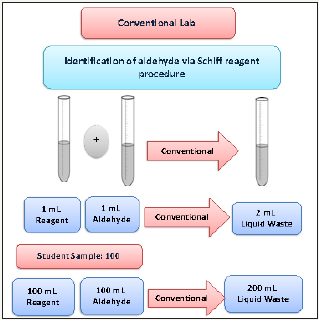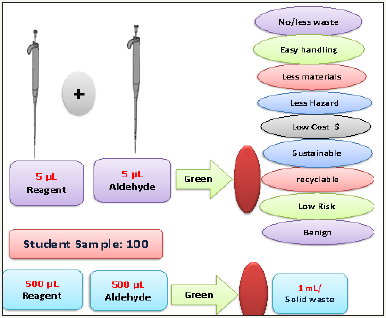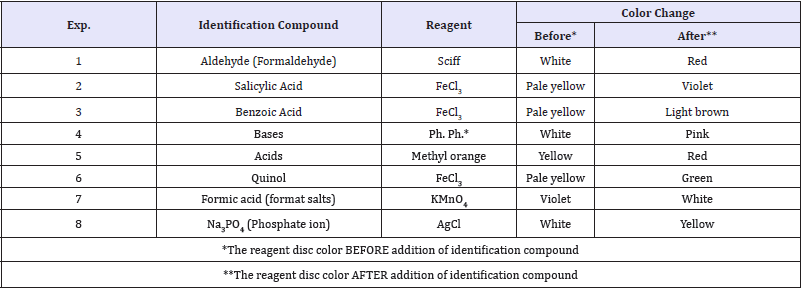- Submissions

Full Text
Research & Development in Material Science
Greener Lab Experiments for Sustainability in Chemistry Education
Fayez M Eissa1, Reda S Abdel Hameed2,3* and Omar MS Ismail3
1Department of Chemistry, Aswan University, Egypt
2Department of Chemistry, Al-Azhar University, Egypt
3Department of Chemistry, Hail University, KSA
*Corresponding author: Reda S Abdel Hameed, Chemistry Department, College of Science, Hail University, Hail 1560, KSA
Submission: April 02, 2018;Published: April 17, 2018

ISSN: 2576-8840
Volume5 Issue3
Abstract
Evaluation of new Greener procedures for chemistry lab experiments as a benign approach for chemical education in chemistry for chemistry undergraduate students. The improved Experimentation represented new, facile, less hazardous, high atom efficiency, and environmentally benign advance in practical chemical education. The newly designed greener procedures were carried out and the advantage over the conventional one was evaluated through a comparative study. The greener experimentation obviously demonstrated the superiority of the greener practice over the conventional one and largely increased the learning outcomes about Green Chemistry and Sustainability for the individuals participated in the study.
Keywords: Green chemistry; Sustainability; Chemistry education; Benign lab; Green experiments
Introduction
Green Chemistry is defined as invention, design, development and application of chemical products and processes to reduce or to eliminate the use and generation of substances hazardous to human health and environment [1].
The challenges in resources and environmental sustainability require more efficient and benign scientific technologies for chemical processes and manufacture of products. Green chemistry addresses such challenges by opening a wide and versatile research scopes, thus allowing the invention of novel experimentations that can maximize the desired products and minimize the waste and byproducts [2]. Therefore, it is essential to direct research, education, and development efforts towards a goal that will constitute a powerful tool for fostering sustainable innovation [3,4]. Green chemistry alone cannot solve the pressing environmental concerns and impacts to our modern era, but applying the twelve principles of green chemistry into practice will eventually help to pave the way to a world where the practice is greener [5,6]. Exploration of alternatives with minimal side products or waste, and elimination of the hazardous materials will be the main thrust area in all aspects of life [7].
Sustainable development is now accepted by governments, Academia, industry and the public as a necessary goal for achieving societal, economic and environmental objectives. Within this, chemistry has a key role to play in maintaining and improving our quality of life [8,9].
Green chemists should assure about the things that they do, they should not only do chemistry, what they were supposed to do, but also they should do it safely [10,11]. This means that it isn’t only important how chemists make something, it is also important that what they make isn’t harmful. In green chemistry, function is not related to hazard, making safe, and non-toxic products and processes is the goal [12,13]. Thus, designing, green and sustainable experimentation in lab and classroom, is a central demand to make chemistry interesting, attractive, and environmentally benign [14].
Our work is a successive approach to apply Green Chemistry and sustainability in laboratory, classroom, academia, manufacture, and finally, the surrounding environment. Our objectives is to conceptualize Green Chemistry and sustainability in education, to change our Chemistry practice to be greener, to reassure the importance of green Chemistry and sustainability, and to design Greener and sustainable Chemistry practice instead of the conventional one.
Results and Discussion
Our study focus on simple chemistry lab experiments that involve the identification of chemicals via a given reagent and the observation is color change. These types of experimentation were conventionally incorporated in all educational study plans from primary schools to universities. The problem with such conventional experiments was the terrible environmental impact that increased the bad tenure of practical chemistry.
Initially, open discussions between participant groups about exchange ideas, share experiences, and best practices that help embed green chemistry and sustainability in academic programs were also conferred.
Figure 1: Graphical representation of conventional lab experimentation.

Remarkably, the conventional procedures of such experiments were well known with its bad reputation and extra cautions due to the high risk as well as the presence of hazardous materials. Also carrying out such procedures in lab, will not be free from accidental hazard. Moreover, at the end, we will face, how and where to dispose the liquid chemical waste? (Figure 1).
On the other hand, the green practice solved the problem through simplicity, usage of less material, safety during procedure, presence of the high environmental impact, nearly absence of liquid chemical waste. In the green procedure, materials were minimized to microscale and the liquid chemical waste was prevented, since the waste will be colored paper discs that were reused in green lab decoration. The environmental impact was high and the student clearly understands the meaning of green chemistry and sustainability in practice (Figure 2).
Figure 2: Graphical representation of Green Lab experimentation.

During practice, Students were asked to individually answer the Test Questions about green chemistry and sustainability, one time before starting the practice, and another one after ending the practice. A comparison between the results, (in percentage), of the Test Questions declared that, the differences in the learning outcomes before and after the practice were highly significant. The significance of the study was obviously noticed from the increased percentage of the answered Test Questions after practice for all individuals comparing with that before. It was obvious that the study practice enabled the students to increase their knowledge about green chemistry and sustainability, thus, increasing the percentage after practice more than before.
The students` comments in the standard lab reports were highly reproductive, and recommended the green procedure over the conventional one due to high atom efficiency, ease of handling, low cost, nearly absence of probable risk and hazardous, waste reuse, and the environmentally benign practice. Also, through discussion groups, the student encouraged such practices that embed green chemistry and sustainability courses in study plans for all levels of education to publish these practices in all aspects of life, labs, classrooms, manufacture and finally the surrounding environment.
Experimental
This study has been carried out with the participation of under graduate chemistry students, (100students/4groups), who studied these experiments via the conventional procedure. Firstly, the students were oriented about the study and accepted all the terms and condition of the study. The students were asked to answer a Test Questions about green chemistry and sustainability. The students requested to carry out both the conventional and the green procedures for each experiment using the given lab manual and report their observation and comments for each experiments. Finally, the students were asked to answer another copy of Test Questions about Green Chemistry and Sustainability. The two copies of Test Questions for each student were corrected and the results (in percentage) were compared to evaluate the learning outcomes and education impacts of the study about green chemistry and sustainability.
Conventional procedure
Both the reagent and the identification compound solution were prepared and its physical characterization was reported. Two clean dry test tubes and two 5mL pipette were placed.
Procedure
In two dry test tubes, Equal volumes (1mL), of both the reagent solution and the Identification compound were taken and mixed in one tube. The color change after mixing was observed and compared with that before mixing. This procedure was repeated twice to insure observation. The liquid chemical waste was measured and kept in the waste bottle. The observation was reported and the environmental impact of the conventional procedure was outlined.
Green procedure
For each Experiment, three filter paper discs, 0.5cm diameter, were impregnated with 5μL/disc by the given reagent solution via means of micropipette and were introduced as reagent kits for the given experiment on Identification Sheet Figure 3. The identification compound solution was prepared and its physical characterization was reported.
Figure 3: Graphical representation of procedure of Green Lab experimentation.

Procedure
On the Identification sheet of the given experiment, about 5μL of the identification compound solution was added via micropipette to two discs of the reagent kits leaving one clear for comparison. The color change of the disc after addition was observed, compared with that of the reagent and recorded in Table 1. The observation was reported and the environmental impact of the green procedure was outlined.
Table 1: Data of some experiments incorporated in the current study.

Recycle and reuse
At the end of the work, the students were invited to practice reusing and recycling by collecting the colored paper discs and make nice Green Lab decoration.
Conclusion
The work clearly conceptualized the practice meaning of green chemistry and sustainability in education. The green procedure was advantageous, and takes superiority over the conventional one. Also it has the applicability to wide variety of lab experimentation with the mission to promote greening of Chemical education. The study recommended embedding greener experimentation in chemistry lab since the green chemistry and sustainability practice in education increased the learning outcomes of the individuals. The study opened research window to encourage benign and sustainable research on educational practice, and to activate embedding green chemistry and sustainability practices in study plans of all education levels.
References
- Anastas P, Warner JC (1998) Green chemistry: theory and practice. Oxford Science Publications, Oxford, UK.
- Chandrasekaran S, Ranu BC, Yadav GD, Bhanumati S (2009) Monographs on green chemistry experiments, GC Task Force, DST.
- Chanshetti U (2014) Green chemistry: environmentally benign chemistry. Int J Adv Res Chem Sci 1(1): 110-115.
- Tanaka K, Toda F (2000) Solvent-free organic synthesis. Chem Rev 100(3): 1025-1074.
- Sjstrm J (2006) Green chemistry in perspective-models for GC activities and GC policy and knowledge areas. Green Chem 8(2): 130-137.
- Taber KS (2014) The impact of chemistry education research on practice: a cautionary tale. Chem Educ Res Pract 15: 410-416.
- Ravichandran S (2010) Green chemistry- a potential tool for chemical synthesis. Int J Chem Tech Res 2(4): 2191.
- Srinivasan KV, Chaskar PK, Dighe SN, Rane DS, Khade PV (2011) Microwave assisted synthesis of fused heterocyclic compounds. Heterocycles 83(11): 2451-2488.
- Marvaniya HM, Modi KN, Sen DJ (2011) Greener reactions under solvent free conditions. Int J Drug Dev & Res 3(2): 42-51.
- Tundo P, Anastas PT (1999) Green chemistry: challenging perspectives, Oxford Science, Oxford, UK.
- Clark JH (1999) Green chemistry: challenges and opportunities, Green Chemistry.
- Cann MC, Dickneider TA (2004) Infusing the chemistry curriculum with green chemistry using real-world examples, web modules, and atom economy in organic chemistry courses. J Chem Educ 81(7): 977-980.
- Mayo DW, Pike RM, Trumper PK (2000) Microscale organic laboratory, (4th edn), John Wiley and Sons Inc, USA.
- Ogino K (2008) Activities of Tohoku association of chemical education, KOBUNSHI. High Polymers 57: 208-209.
© 2018 Reda S Abdel Hameed. This is an open access article distributed under the terms of the Creative Commons Attribution License , which permits unrestricted use, distribution, and build upon your work non-commercially.
 a Creative Commons Attribution 4.0 International License. Based on a work at www.crimsonpublishers.com.
Best viewed in
a Creative Commons Attribution 4.0 International License. Based on a work at www.crimsonpublishers.com.
Best viewed in 







.jpg)






























 Editorial Board Registrations
Editorial Board Registrations Submit your Article
Submit your Article Refer a Friend
Refer a Friend Advertise With Us
Advertise With Us
.jpg)






.jpg)














.bmp)
.jpg)
.png)
.jpg)










.jpg)






.png)

.png)



.png)






